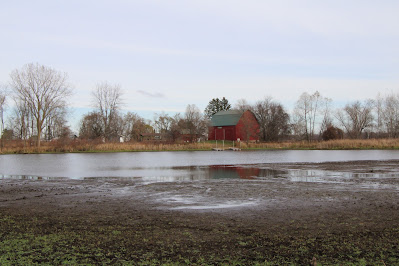The mid-morning temperatures are in the upper 30’s, under partly sunny skies and a gentle west wind, as I begin my hike on a grass trail at Forest Hill Nature Area. Following the path west, I arrive on the edge of Sora Swale, one of several wetlands in the Nature Area. Scanning from here reveals a nearly waterless landscape never before seen. Because of a long-term draught, it looks dramatically different than it did a few years ago (stock photo). Some 30 years ago, Forest Hill Nature Area started out as farmland with no wetlands. During its first few years, with help from the U.S. Fish & Wildlife service, drain tiles were broken, allowing rainwater and snow melt to fill in the low spots and form year-round wetlands, like Sora Swale, that developed into ideal habitat for wildlife. Moving into South woods, I veer off the trail to find a weathered, 2-ton, granite boulder covered with moss, lichens and fungi. This sighting begs two questions: how did it get here and how old is it? Referred to as a glacial erratic, this rock was transported here by a glacier at the end of Michigan’s last ice age, some 12,000 years ago. During its journey south, a much larger boulder was weathered and eroded before coming to rest. Once here, it continued to get smaller and smoother during years and years of exposure to wind, rain, ice and snow. Continuing through South woods, I first glance down to see the trunk of an Aspen tree shredded by a Pileated Woodpecker looking for Carpenter ants and then glance up to see the delicate, yellow, autumn-blooming flowers on a Witch Hazel tree. Looping around to the east, I arrive at another wetland called, Willow Wallow, that too is nearly dried up but, retains enough water to support a family of muskrats. Up ahead, I come upon an abandoned Robin’s nest wedged in the crotch of a Thornapple tree and think about how wise the mother bird was last spring to build her mud-lined, nest in a tree shielded from predators by dense leaves and prickly thorns. Ascending Reflection Hill, I first notice the amber-gold color of a patch of Switch grass and then a leafless tree in the distance laden with orange fruit. Upon a closer look, I identify the fruit as cherry-size, Harvest Gold crabapples. Most crabapples are best suited for preserves rather than eating them raw. Descending the hill, I come to the grassy edge of Grebe Pond and notice, like other wetlands on the property, the water level is very low compared to what it was a few years ago (stock photo). Even so, I spot a few mallards swimming along the far shore. Despite frequently seeing mallards around here, their population is in rapid decline. One reason is the natural cross breeding of wild mallards with game-farm mallards released from hunting preserves. Game-farm mallards are passing on less desirable traits to wild mallards, making it harder for them to survive and thrive in the natural world.
Hunting days, barely begun
Run, run, whitetail run
Far away from the hunter’s gun
Run, run, whitetail run
Some humans shoot for fun
Run, run, whitetail run
Low light of the morning sun
Run, run, whitetail run
Stay alive till season’s done
Run, run, whitetail run
D. DeGraaf

No comments:
Post a Comment